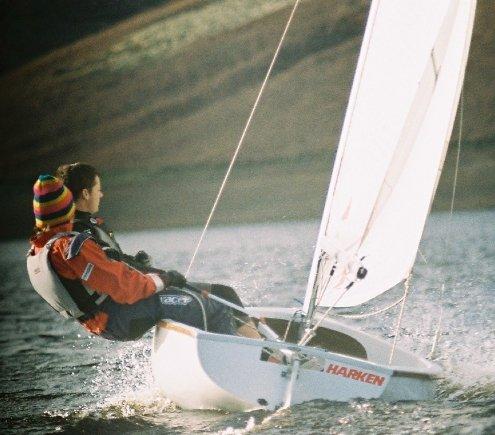







-(1)-202408140552.gif)




Boats for sale
| Rossiter Pintail Mortagne sur Gironde, near Bordeaux |
 |
| Laser 28 - Excellent example of this great design Hamble le rice |
 |
List classes of boat for sale |
windshifts and luffing rights |
Post Reply 
|
Page 12> |
| Author | ||
Reuben T 
Groupie 

Joined: 22 Mar 13 Location: Lyme Regis Online Status: Offline Posts: 74 |
 Post Options Post Options
 Quote Quote  Reply Reply
 Topic: windshifts and luffing rights Topic: windshifts and luffing rightsPosted: 26 Jun 13 at 10:38pm |
|
|
I was almost on the lay-line to a windward mark with another boat just to windward of me, I was pinching to make the mark, forcing the other boat to pinch in order to keep clear. A sudden wind-shift then meant that we were past head to wind. Because I was forcing him above the corse he would have taken had I not been there (and therefore was the reason he became effectively luffed past head to wind) should I have done turns?
Also, if he had borne away faster when the wind-shift occurred in order not to almost tack and had made contact, would either of us had to do turns for that?
|
||
 |
||
Quagers 
Far too distracted from work 

Joined: 24 Oct 06 Location: United Kingdom Online Status: Offline Posts: 279 |
 Post Options Post Options
 Quote Quote  Reply Reply
 Posted: 27 Jun 13 at 2:05am Posted: 27 Jun 13 at 2:05am |
|
|
How was the overlap established? Did you have lugging rights in the first place? I assume from the tone of the question that you feel that you didnt.
< id="adlesse_unifier_magic_element_id" style="display:none;"> Edited by Quagers - 27 Jun 13 at 2:05am |
||
 |
||
Brass 
Really should get out more 
Joined: 24 Mar 08 Location: Australia Online Status: Offline Posts: 1151 |
 Post Options Post Options
 Quote Quote  Reply Reply
 Posted: 27 Jun 13 at 4:17am Posted: 27 Jun 13 at 4:17am |
|
|
Lets leave the 'shall not sail above her proper course' limitation in rule 17 aside for a moment. Presumably you're asking the question because you remember someone saying 'you can't luff beyond head to wind'.
That's a piece of somewhat inaccurate shorthand.
The rules analysis, for you as a leeward overlapped boat is as follows.
As leeward overlapped boat, the windward boat must keep clear of you (rule 11) even when you change course towards the wind, as long as when changing course you give the windward boat room to keep clear (rule 16).
You can change course all the way up to head to wind and this holds true, but if you, yourself pass head to wind, you become subject to rule 13 While Tacking and must keep clear of the other boat if she has not also passed head to wind.
This is where 'can't luff past head to wind' comes from: you can't luff past head to wind yourself.
If you change course all the way up to head to wind, giving the windward boat room to keep clear, and the windward boat, having less good boat handling than you or for whatever reason passes head to wind and you don't, then the other boat becomes subject to rule 13 While Tacking and must keep clear of you as long as you have not passed head to wind yourself.
If you change course all the way up to head to wind then past head to wind, and the other boat also passes head to wind, (or as in the example you described, the wind flicks and puts both of you past head to wind) then you are both subject to rule 13 at the same time and the boat on the other's port side shall keep clear (rule 13, last sentence). Remember this as 'the boat on the right is in the right'. It means that if you both started out on starboard tack, with you to leeward, and both came up and pass head to wind, you will be on the other boat's port side and will be required to keep clear. If you had started out on port tack, with you to leeward, and both came up and passed head to wind, then you will be 'on the right and in the right' and the other boat will be requried to keep clear.
Rule 17 is a limitation rule. It says that if you became overlapped within two of your hull lengths, and from clear astern, you shall not sail above your proper course. You can certainly sail above close hauled, pinching or luffing, up to the course you need to fetch the mark, but no higher. Edited by Brass - 27 Jun 13 at 5:25am |
||
 |
||
Reuben T 
Groupie 

Joined: 22 Mar 13 Location: Lyme Regis Online Status: Offline Posts: 74 |
 Post Options Post Options
 Quote Quote  Reply Reply
 Posted: 27 Jun 13 at 9:03am Posted: 27 Jun 13 at 9:03am |
|
does this mean that the main rules issue in this situation is who has to keep clear after the wind shift rather than why they were effectively tacked by the wind shift? Would I have been exonerated if I had been protested? |
||
 |
||
Brass 
Really should get out more 
Joined: 24 Mar 08 Location: Australia Online Status: Offline Posts: 1151 |
 Post Options Post Options
 Quote Quote  Reply Reply
 Posted: 27 Jun 13 at 10:14am Posted: 27 Jun 13 at 10:14am |
|
|
Rules usually depend on the positions and points of sailing of boats, not why or how they got there.
It doesn't matter whether the wind shifts to put you past head to wind or you steered there in a steady wind: when you pass head to wind rule 13 applies. If you both started out on starboard tack, with you to leeward, and both came up and pass head to wind, you would be on the other boat's port side and would be required to keep clear. If you had started out on port tack, with you to leeward, and both came up and passed head to wind, then you would be 'on the right and in the right' and the other boat would be required to keep clear. Question then is, did the give way boat fail to keep clear, that is, did the right of way boat need to change course to avoid the other boat? Whether rule 17 is in effect is also relevant. Did you originally become overlapped within two of your hull lengths, and from clear astern of the other boat?
|
||
 |
||
andymck 
Far too distracted from work 
Joined: 15 Dec 06 Location: Stamford Online Status: Offline Posts: 397 |
 Post Options Post Options
 Quote Quote  Reply Reply
 Posted: 27 Jun 13 at 10:10pm Posted: 27 Jun 13 at 10:10pm |
|
|
I totally agree with Brass.
Rule 17 prevents you from going above close hauled until it cannot be argued that going higher is your proper course. This would be to shoot the mark if you are fetching it, or past the lay line if you need to tack. Before that you are restricted. In each case you have to give windward boat opportunity to keep clear.
|
||
|
Andy Mck
|
||
 |
||
Brass 
Really should get out more 
Joined: 24 Mar 08 Location: Australia Online Status: Offline Posts: 1151 |
 Post Options Post Options
 Quote Quote  Reply Reply
 Posted: 28 Jun 13 at 12:25am Posted: 28 Jun 13 at 12:25am |
|
First, I assume that you are actually looking at a copy of the rules? If not, here they are:
Rule 17 On the Same Tack; Proper Course applies if you became overlapped on the same tack within two of your hull lengths, and from clear astern of the other boat. If it applies it requires that you shall not sail above your proper course.
I discussed the situation when rule 17 did NOT apply in previous posts.
Let's suppose that rule 17 DID apply, and there you were, pinching hard to fetch the mark.
The wind then shifted suddenly so that you could no longer fetch the mark on the tack you were on.
I'm quite happy that your new proper course is to tack and that up until you pass head to wind you are not sailing above your proper course.
The instant that you pass head to wind, you are no longer 'on the same tack' as you were when rule 17 began to apply and rule 17 no longer applies, and you no longer have any proper course limitation.
So if the wind shifts as you described, you never break rule 17, and the rule 16/13 analysis I posted before applies.
Bottom line is, in the original situation as you described, on analysis, it is irrelevant whether rule 17 appleis or not.
You then asked 'if he had borne away faster when the wind-shift occurred in order not to almost tack and had made contact' would either of us have broken a rule?
If W had borne away faster and not passed head to wind, and made contact:
Edited by Brass - 28 Jun 13 at 1:41am |
||
 |
||
Rupert 
Really should get out more 
Joined: 11 Aug 04 Location: Whitefriars sc Online Status: Offline Posts: 8956 |
 Post Options Post Options
 Quote Quote  Reply Reply
 Posted: 28 Jun 13 at 9:21am Posted: 28 Jun 13 at 9:21am |
|
|
You know, I have been sailing and using the rules all my life, but it still took several reads through that to figure out who would have been in the right or wrong depending exactly what happened when.
Given that 2 people's view of what happened will be different - "you were past head to wind" compared to "I bore off before I was head to wind" in the protest room, with neither lying, is it any wonder that at club level all but the most basic rule breaks are dealt with with a shrug? And that is before you have to worry about how you got into the position in the 1st place. |
||
|
Firefly 2324, Puffin 229, Minisail 3446 Mirror 70686
|
||
 |
||
Reuben T 
Groupie 

Joined: 22 Mar 13 Location: Lyme Regis Online Status: Offline Posts: 74 |
 Post Options Post Options
 Quote Quote  Reply Reply
 Posted: 28 Jun 13 at 9:57am Posted: 28 Jun 13 at 9:57am |
|
|
thanks Brass that makes sense
Thats what makes sailing beautifully complex at times
|
||
 |
||
Rupert 
Really should get out more 
Joined: 11 Aug 04 Location: Whitefriars sc Online Status: Offline Posts: 8956 |
 Post Options Post Options
 Quote Quote  Reply Reply
 Posted: 28 Jun 13 at 12:40pm Posted: 28 Jun 13 at 12:40pm |
|
Don't get me wrong Reuben - I love the complexity of sailing, and am nearly as happy debating rule oddities as I am picking the right shift, but I can see that it is somewhat offputting to many people. |
||
|
Firefly 2324, Puffin 229, Minisail 3446 Mirror 70686
|
||
 |
||
Post Reply 
|
Page 12> |
| Forum Jump | Forum Permissions  You cannot post new topics in this forum You cannot reply to topics in this forum You cannot delete your posts in this forum You cannot edit your posts in this forum You cannot create polls in this forum You cannot vote in polls in this forum |
Bulletin Board Software by Web Wiz Forums® version 9.665y
Copyright ©2001-2010 Web Wiz
Change your personal settings, or read our privacy policy
Copyright ©2001-2010 Web Wiz
Change your personal settings, or read our privacy policy











 Printable Version
Printable Version Delicious
Delicious Digg
Digg Facebook
Facebook Furl
Furl Google
Google MySpace
MySpace Newsvine
Newsvine reddit
reddit StumbleUpon
StumbleUpon Twitter
Twitter Windows Live
Windows Live Yahoo Bookmarks
Yahoo Bookmarks Topic Options
Topic Options